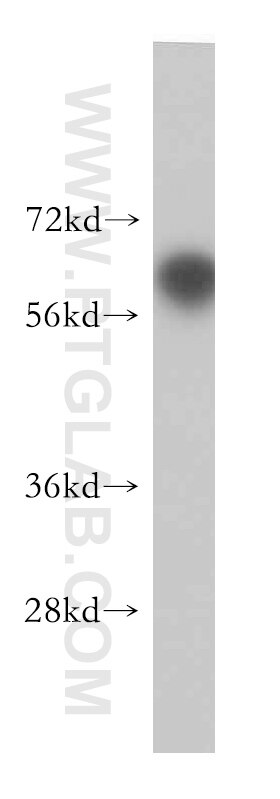Tested Applications
| Positive WB detected in | mouse thymus tissue, rat thymus tissue |
Recommended dilution
| Application | Dilution |
|---|---|
| Western Blot (WB) | WB : 1:1000-1:4000 |
| It is recommended that this reagent should be titrated in each testing system to obtain optimal results. | |
| Sample-dependent, Check data in validation data gallery. | |
Published Applications
| WB | See 3 publications below |
| IF | See 1 publications below |
Product Information
13225-1-AP targets RCBTB2 in WB, IF, ELISA applications and shows reactivity with human, mouse, rat samples.
| Tested Reactivity | human, mouse, rat |
| Cited Reactivity | human, mouse |
| Host / Isotype | Rabbit / IgG |
| Class | Polyclonal |
| Type | Antibody |
| Immunogen |
CatNo: Ag3975 Product name: Recombinant human RCBTB2 protein Source: e coli.-derived, PGEX-4T Tag: GST Domain: 209-551 aa of BC029052 Sequence: TIACGQMCCMAVVDTGEVYVWGYNGNGQLGLGNSGNQPTPCRVAALQGIRVQRVACGYAHTLVLTDEGQVYAWGANSYGQLGTGNKSNQSYPTPVTVEKDRIIEIAACHSTHTSAAKTQGGHVYMWGQCRGQSVILPHLTHFSCTDDVFACFATPAVTWRLLSVEPDDHLTVAESLKREFDNPDTADLKFLVDGKYIYAHKVLLKIRCEHFRSSLEDNEDDIVEMSEFSYPVYRAFLEYLYTDSISLSPEEAVGLLDLATFYRENRLKKLCQQTIKQGICEENAIALLSAAVKYDAQDLEEFCFRFCINHLTVVTQTSGFAEMDHDLLKNFISKASRVGAFKN Predict reactive species |
| Full Name | regulator of chromosome condensation (RCC1) and BTB (POZ) domain containing protein 2 |
| Calculated Molecular Weight | 551 aa, 60 kDa |
| Observed Molecular Weight | 58-60 kDa |
| GenBank Accession Number | BC029052 |
| Gene Symbol | RCBTB2 |
| Gene ID (NCBI) | 1102 |
| RRID | AB_2179570 |
| Conjugate | Unconjugated |
| Form | Liquid |
| Purification Method | Antigen affinity purification |
| UNIPROT ID | O95199 |
| Storage Buffer | PBS with 0.02% sodium azide and 50% glycerol, pH 7.3. |
| Storage Conditions | Store at -20°C. Stable for one year after shipment. Aliquoting is unnecessary for -20oC storage. 20ul sizes contain 0.1% BSA. |
Protocols
| Product Specific Protocols | |
|---|---|
| WB protocol for RCBTB2 antibody 13225-1-AP | Download protocol |
| Standard Protocols | |
|---|---|
| Click here to view our Standard Protocols |
Publications
| Species | Application | Title |
|---|---|---|
Toxicol Appl Pharmacol Proteomic profiling revealed the functional networks associated with mitotic catastrophe of HepG2 hepatoma cells induced by 6-bromine-5-hydroxy-4-methoxybenzaldehyde. | ||
Biomed Environ Sci Ezrin Promotes the Proliferation, Migration, and Invasion of Ovarian Cancer Cells. |






